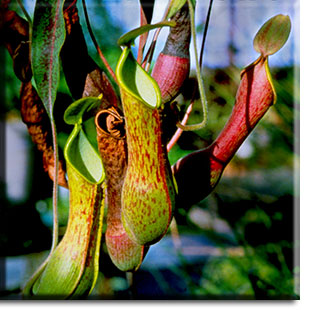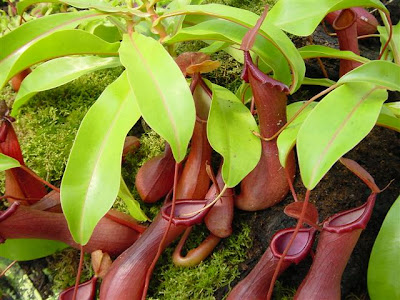
Containers should always have sufficient holes to permit rapid drainage and good soil aeration. Hanging baskets and pots are an excellent way to display larger specimens, and allows for the trailing vines and tendrils to grow without support.
The far more common method of Nepenthes propagation for the hobbyist or small scale nursery is stem cuttings. The exact details of the procedure vary considerably between different growers, so the following are guidelines that can be easily modified.
When to take cuttings: Nepenthes cuttings can be taken at any time of the year, but the cuttings taken when the parent plant is actively growing seem to take faster and have greater success rate. This probably has more to due with the health and vigor of parent plant than the actual cutting time. If the parent plant is growing well, chances are the cuttings will do well under the same conditions. If the parent plant is not doing well, the temperature could be too hot or cold and the cuttings may not root well under those conditions.
What material to take for cuttings: The ideal Nepenthes propagation situation is a plant that has a tall climbing stem with widely-separated leaves and a new basal rosette of leaves. In this case, the climbing stem (either the whole stem or just the tip) can be taken as cutting material leaving the parent plant with an intact basal rosette. If you only want to generate a single new plant, then the active growing tip of the stem with about 2 to 3 leaves is the absolute best cutting material. The stem on the parent plant will generally re-sprout near the tip assuming there are still green leaves on that stem. It will take the parent plant a few months to re-sprout and look presentable again. If you want to generate a large number of plants, then clip the entire climbing stem so the plant has just a basal rosette.
If the plant lacks a basal rosette there are two options. The cuttings can be taken immediately but do leave at least 4 green leaves on the stem. If it is a long stem it may be better to encourage the plant to grow a new basal rosette. You do this by laying the pot on the side and letting the long stem go out horizontally or, even better, hang down. In a few months the plant should sprout a new basal rosette an you can remove the whole climbing stem.

Some growers split the stem up about 10 mm from cut end. Do it under water and in such a way as the blade is NEVER pointed toward any of your body parts you want to keep. After the stem is split, shove a small piece of Sphagnum moss up the slit to hold the two sides somewhat apart. Some growers use rooting hormone on the cut edges. In our experience using hormone is not helpful and too strong a hormone concentration can actually keep the cuttings from forming roots. If the cutting forms a callus but no roots then the hormone is too strong. If you still want to use a hormone, you should never dip the cutting into the jar of hormone as this would contaminate it. Pour out a small amount on a piece of paper and touch the cut edge to hormone on the paper or use a small brush to apply a small amount. If you use a liquid hormone use the amount recommended for soft wood cuttings at the recommended time in the solution.
This once named cultivar was found a top a tall, misty mountain in the tropics region where Nepenthes originate from. A expedition was planned up to the mountain in the late 80′s to see what types of Nepenthes lived up there. Once they reached the top, the Nepenthes experts from Borneo Exotics Inc. found a Nepenthes Truncata that was way darker than any other of the normal specimens observed in cultivation. The big Nepenthes was lofted in the notch of a high tree. Since the plant was flowering female, the experts decided to collect seeds from it, and headed back down to the nursery.
Many years later seven dark seedlings were chosen out of the seed batch and have since been raised to big tall plants. Each plant was given a cultivar name like N. Truncata ‘king of clubs” and so forth. The two most interesting Nepenthes, N. Truncata “Queen of Hearts” and N. Truncata “King of Spades”, decided to flower. Now, their colorful and sought after offspring have been spread to growers all around the world, including me.
No comments:
Post a Comment